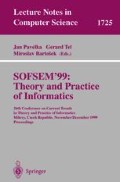Abstract
Neuroid as a kind of a programmable neuron has been introduced by L. G. Valiant in 1988. Essentially it is a combination of a standard threshold element with a mechanism that allows for modification of neuroid’s computational behaviour. This is done by changing the settings of its weights and of its threshold in the course of computation. It is shown that the computational power of neuroidal nets crucially depends on the size of allowable weights. For bounded weights their power equals to that of that of finite automata, whereas for unbounded weights finite neuroidal nets posses the computational power of Turing machines. It follows that the former neuroidal nets are computationally equivalent to standard, non-programmable discrete neural nets, while, quite surprisingly, the latter nets are computationally equivalent to a certain kind of analog neural nets.
This research was supported by GA ČR Grant No. 201/98/0717.
Access this chapter
Tax calculation will be finalised at checkout
Purchases are for personal use only
Preview
Unable to display preview. Download preview PDF.
References
Hopcroft, J. E.-Ullman, J. D.: Formal Languages and Their Relation to Automata. Addison-Wesley, Reading, Mass., 1969.
Siegelmann, H. T.-Sonntag, E. D.: On Computational Power of Neural Networks. J. Comput. Syst. Sci., Vol. 50, No. 1, 1995, pp. 132–150.
Šíma, J.-Wiedermann, J.: Theory of Neuromata. Journal of the ACM, Vol. 45, No. 1, 1998, pp. 155–178.
Valiant, L.: Functionality in Neural Nets. Proc. 7th Nat. Conf. on Art. Intelligence, AAAI, Morgan Kaufmann, San Mateo, CA, 1988, pp. 629–634.
Valiant, L. G.: Circuits of the Mind. Oxford University Press, New York, Oxford, 1994, 237 p., ISBN 0-19-508936-X.
Valiant, L. G.: Cognitive Computation (Extended Abstract). In: Proc. 38th IEEE Symp. on Fond. of Comp. Sci., IEEE Press, 1995, p. 2–3.
Wiedermann, J.: Simulated Cognition: A Gauntlet Thrown to Computer Science. To appear in ACM Computing Surveys, 1999.
Wiedermann, J.: The Computational Limits to the Cognitive Power of Neuroidal Tabula Rasa. To appear in: Proc. of the 10th Int. Conf. on Algorithmic Learning Theory ALT’99, Springer-Verlag, Berlin, 1999.
Author information
Authors and Affiliations
Editor information
Editors and Affiliations
Rights and permissions
Copyright information
© 1999 Springer-Verlag Berlin Heidelberg
About this paper
Cite this paper
Wiedermann, J. (1999). Computational Power of Neuroidal Nets. In: Pavelka, J., Tel, G., Bartošek, M. (eds) SOFSEM’99: Theory and Practice of Informatics. SOFSEM 1999. Lecture Notes in Computer Science, vol 1725. Springer, Berlin, Heidelberg. https://doi.org/10.1007/3-540-47849-3_36
Download citation
DOI: https://doi.org/10.1007/3-540-47849-3_36
Published:
Publisher Name: Springer, Berlin, Heidelberg
Print ISBN: 978-3-540-66694-3
Online ISBN: 978-3-540-47849-2
eBook Packages: Springer Book Archive

